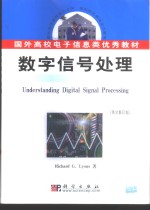

数字信号处理 英文PDF电子书下载
- 电子书积分:16 积分如何计算积分?
- 作 者:(美)Richard G. Lyons著
- 出 版 社:北京:科学出版社
- 出版年份:2003
- ISBN:7030111508
- 页数:517 页
1 DISCRETE SEQUENCES AND SYSTEMS 1
1.1 Discrete Sequences and Their Notation 2
1.2 Signal Amplitude,Magnitude,Power 8
1.3 Signal Processing Operational Symbols 10
1.4 Introduction to Discrete Linear Time-Invariant Systems 12
1.5 Discrete Linear Systems 13
1.6 Time-Invariant Systems 18
1.7 The Commutative Property of Linear Time-Invariant Systems 20
1.8 Analyzing Linear Time-Invariant Systems 20
2 PERIODIC SAMPLING 23
2.1 Aliasing: Signal Ambiguity in the Frequency Domain 23
2.2 Sampling Low-Pass Signals 29
2.3 Sampling Bandpass Signals 32
2.4 Spectral Inversion in Bandpass Sampling 43
3 THE DISCRETE FOURIER TRANSFORM 49
3.1 Understanding the DFT Equation 50
3.2 DFT Symmetry 63
3.3 DFT Linearity 65
3.4 DFT Magnitudes 66
3.5 DFT Frequency Axis 67
3.6 DFT Shifting Theorem 68
3.7 Inverse DFT 70
3.8 DFT Leakage 71
3.9 Windows 80
3.10 DFT Scalloping Loss 88
3.11 DFT Resolution, Zero Stuffing, and Frequency-Domain Sampling 89
3.12 DFT Processing Gain 93
3.13 The DFT of Rectangular Functions 97
3.14 The DFT Frequency Response to a Complex Input 119
3.15 The DFT Frequency Response to a Real Cosine Input 123
3.16 The DFT Single-Bin Frequency Response to a Real Cosine Input 125
4 THE FAST FOURIER TRANSFORM 129
4.1 Relationship of the FFT to the DFT 130
4.2 Hints on Using FFTs in Practice 131
4.3 FFT Software Programs 136
4.4 Derivation of the Radix-2 FFT Algorithm 136
4.5 FFT Input/Output Data Index Bit Reversal 145
4.6 Radix-2 FFT Butterfly Structures 146
5 FINITE IMPULSE RESPONSE FILTERS 157
5.1 An Introduction to Finite Impulse Response FIR Filters 158
5.2 Convolution in FIR Filters 163
5.3 Low-Pass FIR Filter Design 174
5.4 Bandpass FIR Filter Design 191
5.5 Highpass FIR Filter Design 193
5.6 Remez Exchange FIR Filter Design Method 194
5.7 Half-Band FIR Filters 197
5.8 Phase Response of FIR Filters 199
5.9 A Generic Description of Discrete Convolution 204
6 INFINITE IMPULSE RESPONSE FILTERS 219
6.1 An Introduction to Infinite Impulse Response Filters 220
6.2 The Laplace Transform 223
6.3 The z-Transform 238
6.4 Impulse Invariance IIR Filter Design Method 254
6.5 Bilinear Transform IIR Filter Design Method 272
6.6 Optimized IIR Filter Design Method 284
6.7 Pitfalls in Building IIR Digital Filters 286
6.8 Cascade and Parallel Combinations of Digital Filters 290
6.9 A Brief Comparison of IIR and FIR Filters 292
7 ADVANCED SAMPLING TECHNIQUES 297
7.1 Quadrature Sampling 297
7.2 Quadrature Sampling with Digital Mixing 301
7.3 Digital Resampling 303
8 SIGNAL AVERAGING 319
8.1 Coherent Averaging 320
8.2 Incoherent Averaging 327
8.3 Averaging Multiple Fast Fourier Transforms 330
8.4 Filtering Aspects of Time-Domain Averaging 340
8.5 Exponential Averaging 341
9 DIGITAL DATA FORMATS AND THEIR EFFECTS 349
9.1 Fixed-Point Binary Formats 349
9.2 Binary Number Precision and Dynamic Range 356
9.3 Effects of Finite Fixed-Point Binary Word Length 357
9.4 Floating-Point Binary Formats 375
9.5 Block Floating-Point Binary Format 381
10 DIGITAL SIGNAL PROCESSING TRICKS 385
10.1 Frequency Translation without Multiplication 385
10.2 High-Speed Vector-Magnitude Approximation 400
10.3 Data Windowing Tricks 406
10.4 Fast Multiplication of Complex Numbers 411
10.5 Efficiently Performing the FFT of Real Sequences 412
10.6 Calculating the Inverse FFT Using the Forward FFT 425
10.7 Fast FFT Averaging 429
10.8 Simplified FIR Filter Structure 430
10.9 Accurate A/D Converter Testing Technique 432
10.10 Fast FIR Filtering Using the FFT 435
10.11 Calculation of Sines and Cosines of Consecutive Angles 436
10.12 Generating Normally Distributed Random Data 438
APPENDIX A. THE ARITHMETIC OF COMPLEX NUMBERS 443
A.1 Graphical Representation of Real and Complex Numbers 443
A.2 Arithmetic Representation of Complex Numbers 444
A.3 Arithmetic Operations of Complex Numbers 446
A.4 Some Practical Implications of Using Complex Numbers 453
APPENDIX B. CLOSED FORM OF A GEOMETRIC SERIES 455
APPENDIX C. COMPLEX SIGNALS AND NEGATIVE FREQUENCY 458
C.1 Development of Imaginary Numbers 460
C.2 Representing Real Signals Using Complex Phasors 462
C.3 Representing Real Signals Using Negative Frequencies 467
C.4 Complex Signals and Quadrature Mixing 471
APPENDIX D. MEAN, VARIANCE, AND STANDARD DEVIATION 476
D.1 Statistical Measures 476
D.2 Standard Deviation, or RMS, of a Continuous Sinewave 480
D.3 The Mean and Variance of Random Functions 481
D.4 The Normal Probability Density Function 484
APPENDIX E. DECIBELS (dB AND dBm) 486
E.1 Using Logarithms to Determine Relative Signal Power 486
E.2 Some Useful Decibel Numbers 492
E.3 Absolute Power Using Decibels 493
APPENDIX F. DIGITAL FILTER TERMINOLOGY 494
Index 507
- 《数字影视特效制作技法解析》王文瑞著 2019
- 《基于地质雷达信号波的土壤重金属污染探测方法研究》赵贵章 2019
- 《大数据Hadoop 3.X分布式处理实战》吴章勇,杨强 2020
- 《数字插画实战 人像创作30例》王鲁光著 2019
- 《中国电子政务发展报告 2018-2019 数字中国战略下的政府管理创新》何毅亭主编 2019
- 《信号 修订版》铁道部通信信号公司研究设计院 1979
- 《烧结法处理非常规含铁资源研究》王哲著 2018
- 《无机元素原子光谱分析样品预处理技术》吴瑶庆 2019
- 《三维数字化创新设计手册》霍有朝主编 2019
- 《农村生活污水处理工艺与技术应用》李灵娜著 2019
- 《指向核心素养 北京十一学校名师教学设计 英语 七年级 上 配人教版》周志英总主编 2019
- 《《走近科学》精选丛书 中国UFO悬案调查》郭之文 2019
- 《北京生态环境保护》《北京环境保护丛书》编委会编著 2018
- 《中医骨伤科学》赵文海,张俐,温建民著 2017
- 《美国小学分级阅读 二级D 地球科学&物质科学》本书编委会 2016
- 《指向核心素养 北京十一学校名师教学设计 英语 九年级 上 配人教版》周志英总主编 2019
- 《强磁场下的基础科学问题》中国科学院编 2020
- 《小牛顿科学故事馆 进化论的故事》小牛顿科学教育公司编辑团队 2018
- 《小牛顿科学故事馆 医学的故事》小牛顿科学教育公司编辑团队 2018
- 《高等院校旅游专业系列教材 旅游企业岗位培训系列教材 新编北京导游英语》杨昆,鄢莉,谭明华 2019
